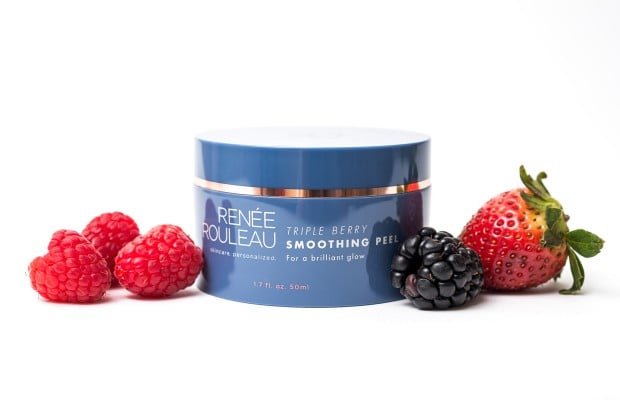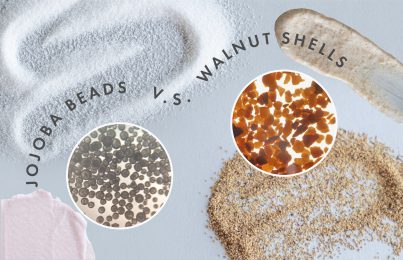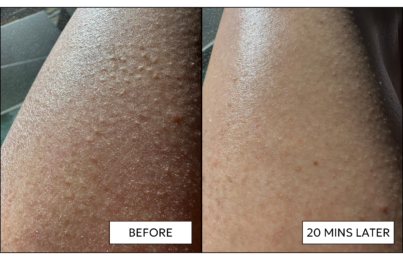Updated 12/1/17. Physical or chemical exfoliation? Learn the difference and why exfoliation is so necessary for the health of the all skin types.
What Is Skin Exfoliation? Exfoliation is defined as the removal of surface dry skin cells.
How Do I Know If I Need To Exfoliate? A simple test you can do at home to see if you have surface dry skin cells on your skin is to take a piece of clear tape and apply it to the forehead. Rub it gently and remove. Look at the tape, and if there are little pieces of flaky skin, then you need to exfoliate!
Why Is Exfoliation So Important? Exfoliation is considered one of the most important techniques that you can perform on your skin to resolve certain skin problems as well as to achieve healthy and glowing skin. As a esthetician with 30 years of working with clients, I have seen exfoliation transform the skin. Like it did for this client of mine.
What Skin Care Problems Does Exfoliation Help to Improve?
FOR BLEMISHED SKIN. Exfoliation should be the main focus of a home care program. So often, we are told to dry out the skin with harsh acne products. Although this will destroy acne-causing bacteria, it tends to dry out the skin, and this usually results in not only irritated skin but also in future breakouts. Why? Because as you over-dry the skin, you create surface dry skin cell buildup. This then acts as a barrier to trap oil in the skin, thereby starting a cycle of new breakouts. One of the best products to reduce bacteria on the skin while exfoliating and cleaning clogged pores is BHA Clarifying Serum. For teens and adult acne, this product works incredibly well to give a newly refined smoothness and clarity.
FOR POST-BREAKOUT RED/DARK MARKS. Often, the real concern is not so much the actual blemishes, but rather the red, dark marks that remain on the skin long after the breakout has healed. The key to fading those post-breakout marks is to increase your exfoliation. The more you remove the surface damaged cells, the more you are ridding the skin of the dark marks and encouraging the formation of new healthy (non-scarred) skin cells. The result is more even-toned skin with less scarring. I highly recommend Post-Breakout Fading Gel to fade stubborn acne scars.
FOR CLOGGED PORES. Clogged pores aren’t infected blemishes, but rather blackheads, small whiteheads, and little clogged bumps on the skin, often on the forehead. The same rules apply as with blemished skins. The more you remove surface dry skin cells (usually caused by using harsh, drying products), the less oil will stay trapped and congested in the pores. Wash with AHA/BHA Blemish Control Cleanser (named “Best Cleanser for Oily/Acne Prone Skin” by Allure Magazine) to reduce breakouts and clear clogged pores.
FOR HYPERPIGMENTATION. These are the brown spots that come from age, pregnancy, hormonal changes, and genetics. These spots tend to become more apparent and darker as the skin ages. Exfoliation is beneficial for breaking up the pigmented cells to allow them to fade. Combined with a skin lightening agent, such as Vitamin C (found in Vitamin C & E Treatment) or Hydroquinone (available OTC or by prescription), exfoliation will help accelerate the fading process.
FOR DRY SKIN. Especially in the winter, exfoliation is very important. So often when the skin is dry, we tend to load up on heavier creams to compensate for the dryness. But dry skin means you have dry skin cell buildup. And the more you layer on the heavier creams, the more you are trying to re-hydrate dry skin cells, which makes no sense! Instead, increase your exfoliation to remove the dry skin cells, and then moisturize the new skin cells, resulting in a moister skin. Learn the difference between dry and dehydrated skin.
FOR THOSE WHO DESIRE SMOOTHER SKIN. One way to instantly smooth the skin is to exfoliate! When you rid the skin of the surface dry skin cells, you create a smoother appearance. Triple Berry Smoothing Peel gives instant results.
FOR THOSE CONCERNED ABOUT WRINKLES. The skin’s natural exfoliation process slows as the skin ages, resulting in an accumulation of dry skin cells. As you increase your exfoliation, you are tricking the skin into acting young again. A special type of exfoliant that works particularly well within the deeper layers of the skin skin to jump start tired, aging cells is the ingredient retinoic acid or retinol. It repairs the lower layers where collagen and elastin reside and with continued use, skin will look smoother and younger each day. Advanced Resurfacing Serum is a great formula for sensitive skin and does not require a prescription.
How Often Should I Exfoliate? Generally no more than five times a week. There are two types of exfoliants. First, a “chemical” or “acid” exfoliant does the work for you. You apply it, leave it on the skin, and it works to dissolve the dry skin cells. These exfoliants include ingredients such as glycolic, lactic and salicylic acids and enzymes such as pumpkin, papaya, and pineapple. Second, a “physical” exfoliant means that you have to do the work. These exfoliants include facial brushes, sponges, and facial scrubs. A combination of both physical and chemical exfoliants will give your skin the best results.
For most skin types, this would be a an exfoliating acid serum used under a moisturizer at night for three nights on, three nights off. This way, you’re still getting an intensive exfoliation, but you also give your skin a break. You would then combine this with a very mild facial scrub twice a week in the morning to lift off and remove the dissolved skin cells.
To find out which exfoliants are best for you, take this Skin Type Quiz.
How Does A Person Know If They Are Getting Too Much Exfoliation? If you use a facial scrub and your skin turns bright red and feels irritated afterwards, it probably means that the grains used in the scrub are too large—or you simply applied too much pressure when massaging it over your face. I suggest avoiding natural scrubs, such as those with walnut husks. These have sharp edges that can lacerate the skin. Look for natural, non-plastic jojoba beads as they will roll across the skin and not cause irritation. If you are using chemical exfoliants and your skin starts to dry out, you may be removing too much of the skin’s protective barrier, allowing moisture to escape. Cut back and the skin’s barrier should naturally repair itself.
The Bottom Line. The goal with your skin is to exfoliate as much as possible, with minimal irritation. The skin likes little boosts but not on an everyday basis. Read The Beginner’s Guide to Using Exfoliants.
Which skin care products are best for you? See our nine skin types or take the Skin Type Quiz and get products recommended.
Need expert advice from a licensed esthetician? Schedule a virtual consultation to get customized advice in person, over the phone or online via Skype or FaceTime.
For more expert advice check out the blog. Also, sign up for our skin tip e-newsletter, follow Renée Rouleau on Twitter and Instagram and join the discussion on our Facebook page. You’ll be your own skin care expert in no time. Get the #ReneeRouleauGlow!
Celebrity Esthetician & Skincare Expert
As an esthetician trained in cosmetic chemistry, Renée Rouleau has spent 35 years researching skin, educating her audience, and building an award-winning line of products. Her hands-on experience as an esthetician and trusted skin care expert has created a real-world solution — products that are formulated for nine different types of skin so your face will get exactly what it needs to look and feel its best. Trusted by celebrities, editors, bloggers, and skincare obsessives around the globe, her vast real-world knowledge and constant research are why Marie Claire calls her “the most passionate skin practitioner we know.”




Comments:
Kind of surprised you would recommend exfoliants with microbeads considering how harmful they are to the planet.
Posted By: Meredith |
I don’t recommend using plastic beads and I don’t use any in my exfoliators.
Posted By: Renée Rouleau |